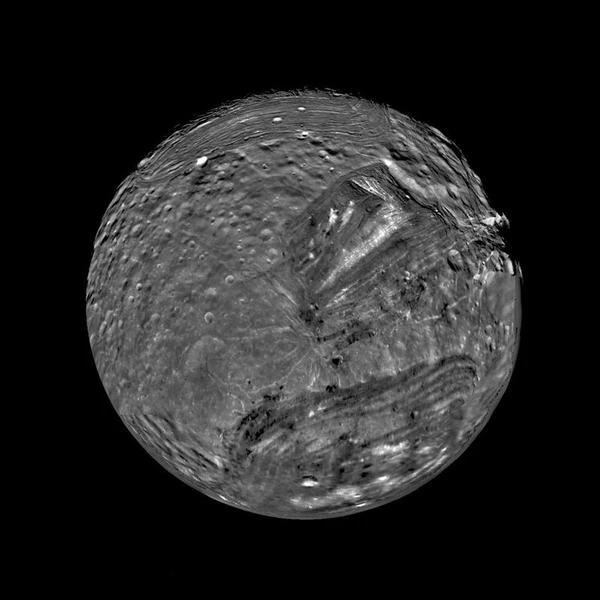
Miranda, one of the five major satellites of Uranus, was discovered in 1948 by Gerard Kuiper (1905-1973). With a diameter of approximately 470 km, this small moon stands out with a chaotic surface, marked by fractures, steep cliffs, and disjointed geological formations called coronae. This complex and seemingly random geomorphology makes it a unique object in the entire solar system. The most detailed observation of Miranda comes from the flyby of the Voyager 2 probe in January 1986.
Miranda's surface is a patchwork of terrains of different elevations, textures, and ages. The coronae (oval structures with raised edges) could be manifestations of internal uplift caused by localized heating of the mantle, possibly due to a past episode of orbital resonance with Umbriel or Ariel. Other hypotheses suggest that Miranda may have been shattered and then reassembled by gravitational accretion, explaining the disorderly juxtaposition of terrains. It features cliffs over 20 km high, such as Verona Rupes, as well as deep canyons and possible traces of cryovolcanism.
Miranda orbits Uranus at approximately 130,000 km, on a highly inclined equatorial plane relative to the ecliptic, a consequence of Uranus' extreme tilt. Its orbital period is 1.41 Earth days. Its average density is about 1.2 g/cm³, suggesting a mixture of water ice and silicates. The weak tidal heating is insufficient to explain its current geological complexity, unless there was past resonant orbital migration. This scenario reinforces the idea of an intense thermal and dynamic history despite its modest size.
Miranda's morphological diversity makes it a prime target for future exploration missions of the Uranian system. It serves as a natural laboratory for studying planetary resurfacing mechanisms, ice tectonics, and the thermal evolution of small bodies. Its internal structure may still contain heat pockets or relics of a buried ocean, raising fundamental questions about the ability of icy satellites to maintain geological activity over billions of years.